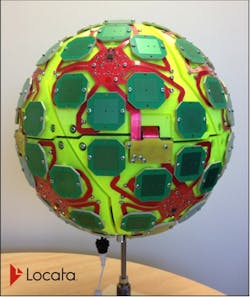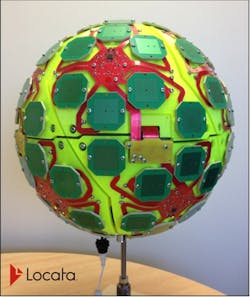U.S. Air Force Institute of Technology leverages Locata technology for new, satellite-based GPS technology development
LAS VEGAS, 19 Sept. 2013. The U.S. Air Force Institute of Technology (AFIT) signed a co-operative research & development agreement (CRADA) with Locata Corp. to build and demonstrate new Locata technology to bring new capabilities to satellite-based global positioning system (GPS) receivers.
The CRADA is specifically directed to evaluate Locata's patented Vray switching antenna and new correlator technologies for multipath mitigation in position receivers that run at GPS frequencies. Locata engineers are transferring to AFIT the knowledge and experience they have gained with existing commercial Vray systems, enabling AFIT researchers and engineers to familiarize themselves with the new antenna's characteristics and providing AFIT with a platform to develop GPS-specific versions of Locata's correlator and switching algorithms.
AFIT will design and build a GPS-frequency, multi-element switching antenna prototype based on Locata Vray patents. When built, AFIT officials intend to use the GPS receiver and prototype Vray to demonstrate the feasibility of using Locata technology to improve GPS receiver performance.
"If this CRADA is successful, the technology could enable significantly improved technical performance and a reduction in the cost of multiple-element GPS antennas,” says Dr. John Raquet, director, Advanced Navigation Technology Center, AFIT. “AFIT is excited to investigate this technology for the benefits it will potentially bring to American warfighters."
After these initial prototypes are built, AFIT engineers plan to design and test several other GPS-based versions of Locata's flexible switching antenna array to assess how Locata's Vray antennas can be adapted to use cases of specific interest to the military. Designs already discussed with Locata include: standalone antennas, a version built into helmets, and arrays conformal to a vehicle's frame (e.g., flattened for a Humvee's roof, curved for aircraft fuselages, etc).
AFIT personnel visited Locata's head office for a week of detailed, wide-ranging engineering briefings on the design fundamentals underpinning this new type of antenna. Locata hosted AFIT Director Dr. John Raquet and engineers Dr. Peter Collins and Jason Barhorst in multiple engineering meetings where Locata's current production Vray Orb-80 antenna was revealed for the first time, and then closely analyzed. AFIT and Locata engineers then workshopped the modifications and design choices required to integrate the Locata designs into a GPS form-factor.
"AFIT brings exceptional skills to this important integration of Locata technology, directed to the creation of a new class of antennas for GPS. I'm certain our collaboration, along with access to the USAF's unrivaled prototyping and test facilities, will deliver ground-breaking improvements for future GPS devices," explains Nunzio Gambale, Locata Corp. CEO and co-founder. After the introductory technical meetings AFIT immediately started working on the milestones laid out in the CRADA project plan. When the project is completed, AFIT will produce a CRADA Final Report which will:
include results and the measured performance of AFIT's Locata-enhanced GPS receiver; and
describe design considerations gleaned from AFIT's experience with the new Locata Vray antennas and correlators, as applied to GPS.


